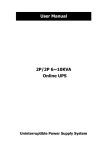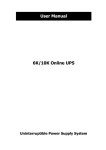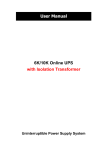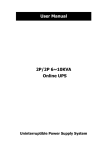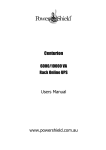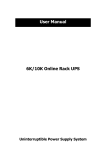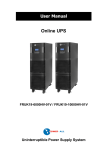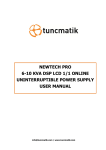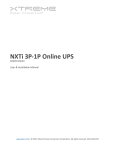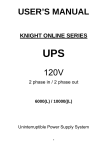Download 4,8 kVA AC Converters 6,0 kVA AC Converters User Manual
Transcript
User Manual EN 4,8 kVA AC Converters 6,0 kVA AC Converters Rev. 1.0-12.07.24 Please comply with all warnings and operating instructions in this manual strictly. Save this manual properly and read carefully the following instructions before installing the unit. Do not operate this unit before reading through all safety information and operating instructions carefully. 1 Table of Contents 1. SAFETY AND EMC INSTRUCTIONS .................................................................................3 1-1. TRANSPORTATION AND STORAGE ........................................................................................ 1-2. PREPARATION ................................................................................................................... 1-3. INSTALLATION .................................................................................................................... 1-4. OPERATION ....................................................................................................................... 1-5. STANDARDS ...................................................................................................................... 2. INSTALLATION AND OPERATION ....................................................................................5 2-1. UNPACKING AND INSPECTION .............................................................................................. 2-2. REAR PANEL VIEW ............................................................................................................. 2-3. CONVERTER INSTALLATION ............................................................................................. 3. OPERATIONS .....................................................................................................................8 3-1. BUTTON OPERATION .......................................................................................................... 3-2. LED INDICATORS AND LCD PANEL ..................................................................................... 3-3. AUDIBLE ALARM ................................................................................................................ 3-4. CONVERTER OPERATION................................................................................................ 3-6. ABBREVIATION MEANING IN LCD DISPLAY ........................................................................... 3-7. LCD SETTING ................................................................................................................... 3-8. OPERATING MODE/STATUS DESCRIPTION ........................................................................... 3-9. FAULT CODE ..................................................................................................................... 3-10. W ARNING INDICATOR ....................................................................................................... 4. TROUBLE SHOOTING .....................................................................................................16 5. STORAGE AND MAINTENANCE .....................................................................................17 5-1. STORAGE .......................................................................................................................... 5-2. MAINTENANCE ................................................................................................................................................. 2 1. Safety and EMC instructions Please read carefully the following user manual and the safety instructions before installing the unit or using the unit! 1-1. Transportation and Storage Please transport the UPS system only in the original package to protect against shock and impact. The UPS must be stored in the room where it is ventilated and dry. 1-2. Preparation Condensation may occur if the UPS system is moved directly from cold to warm environment. The UPS system must be absolutely dry before being installed. Please allow at least two hours for the UPS system to acclimate the environment. Do not install the CONVERTER system near water or in moist environments. Do not install the CONVERTER system where it would be exposed to direct sunlight or nearby heater. Do not block ventilation holes in the CONVERTER housing. 1-3. Installation Do not connect appliances or devices which would overload the CONVERTER (e.g. big motor-type equipment)) to the CONVERTER output sockets or terminal. Place cables in such a way that no one can step on or trip over them. Do not block air vents in the housing of CONVERTER. The CONVERTER must be installed in a location with good ventilation. Ensure enough space on each side for ventilation. CONVERTER has provided earthed terminal, in the final installed system configuration, equipotential earth bonding to the external CONVERTER battery cabinets. The CONVERTER can be installed only by qualified maintenance personnel. An appropriate disconnect device as short-circuit backup protection should be provided in the building wiring installation. An integral single emergency switching device which prevents further supply to the load by the CONVERTER in any mode of operation should be provided in the building wiring installation. Connect the earth before connecting to the building wiring terminal. Installation and Wiring must be performed in accordance with the local electrical laws and regulations. 3 1-4. Operation Do not disconnect the earth conductor cable on the CONVERTER or the building wiring terminals in any time since this would cancel the protective earth of the CONVERTER system and of all connected loads. The CONVERTER system features its own, internal current source (batteries). The CONVERTER output sockets or output terminal blocks may be electrically live even if the CONVERTER system is not connected to the building wiring outlet. In order to fully disconnect the CONVERTER system, first press the “OFF” button and then disconnect the mains. Ensure that no liquid or other foreign objects can enter into the CONVERTER system. The CONVERTER can be operated by any individuals with no previous experience. 1-5. Standards * Safety IEC/EN 62040-1-1 * EMI Conducted Emission...............................:IEC/EN 62040-2 Category C3 Radiated Emission..................................:IEC/EN 62040-2 Category C3 *EMS ESD.........................................................:IEC/EN 61000-4-2 Level 4 RS........................................................ ...:IEC/EN 61000-4-3 Level 3 EFT......................................................... :IEC/EN 61000-4-4 Level 4 SURGE................................................... :IEC/EN 61000-4-5 Level 4 CS........................................................... :IEC/EN 61000-4-6 Level 3 Power-frequency Magnetic field.............. :IEC/EN 61000-4-8 Level 3 Low Frequency Signals............................:IEC/EN 61000-2-2 Warning: This is a product for commercial and industrial application in the second environment-installation restrictions or additional measures may be needed to prevent disturbances. 4 2. Installation and Operation 2-1. Unpacking and Inspection Unpack the package and check the package contents. The shipping package contains: ● One CONVERTER ● One user manual ● One monitoring software CD ● One RS-232 cable (option) ● One USB cable ● One EPO plug NOTE: Before installation, please inspect the unit. Be sure that nothing inside the package is damaged during transportation. Do not turn on the unit and notify the carrier and dealer immediately if there is any damage or lacking of some parts. Please keep the original package in a safe place for future use. 2-2. Rear Panel View Diagram 1: Rear Panel Overlook Diagram 2: Input/Output Terminal Diagram 3: rear panel Diagram 4: Input/Output terminal 5 1. RS-232 communication port 2. USB communication port 3. Emergency power off function connector (EPO connector) 4. not available 5. not available 6. Intelligent slot 7. Cooling fan 8. not usable in converter configuration 9. not usable in converter configuration 10. Input circuit breaker 11. Output receptacles: connect to mission-critical loads 12. Output circuit breaker for receptacles 13. Input/Output terminal (Refer to Diagram 2 for the details) 14. Output terminal: connect to mission-critical loads 15. Programmable output terminal: connect to non-critical loads 16. not available 17. Utility input terminal 18. Grounding terminal 19. not available 2-3. CONVERTER Installation Installation and wiring must be performed in accordance with the local electric laws/regulations and execute the following instructions by professional personnel. 1) Make sure the mains wire and breakers in the building are enough for the rated capacity of CONVERTER to avoid the hazards of electric shock or fire. NOTE: Do not use the wall receptacle as the input power source for the CONVERTER, as its rated current is less than the CONVERTER’s maximum input current. Otherwise the receptacle may be burned and destroyed. 2) Switch off the mains switch in the building before installation. 3) Turn off all the connected devices before connecting to the CONVERTER and then switch off the internal output breaker. 4) Prepare wires based on the following table: Model Wiring spec (AWG) Input Output Ground 4,8 kVA 10 10 10 6,0 kVA 8 8 8 NOTE 1: The cable for 4,8 kVA should be able to withstand over 40A current. The cable for 6 kVA should be able to withstand over 63A current NOTE 2: The selections for color of wires should be followed by the local electrical laws and regulations. 6 5) Remove the terminal block cover on the rear panel of CONVERTER. Then connect the wires according to the following terminal block diagrams: (Connect the earth wire first when making wire connection. Disconnect the earth wire last when making wire disconnection!) Output 1 Line Input Neutral Output 1 Neutral Input Line Output 2 Line Output 2 Neutral Terminal Block wiring diagram of Tower units Input Neutral Output Line Input Line Output Neutral Ground Terminal Block wiring diagram for Rack units NOTE 1: Make sure that the wires are connected tightly with the terminals. NOTE 2: There are two kinds of outputs: output terminal/outlets and programmable terminal. Please connect non-critical devices to the programmable terminal and critical devices to the output terminal/outlets. During power failure, you may extend the backup time to critical devices by setting shorter backup time for non-critical devices. NOTE 3: The internal output breaker is used to cut off the output, but we suggest you to install an external output breaker between the output terminal and the load. This breaker should be installed in an easy access area which will allow you to cut off the output immediately in an emergency. And the breaker should be equipped with leakage current protection if necessary. 6) Insert the EPO plug into the EPO slot on the rear panel. 7) Put the terminal block cover back to the rear panel of the CONVERTER. Warning: (Only for standard model) ● Make sure the CONVERTER is not turned on before installation. The CONVERTER should not be turned on during wiring connection. ● Do not try to modify the standard model to the long-run model. Particularly, do not try to connect the standard internal battery to the external battery. The battery type and voltage may be different. If you connect them together, it maybe causes the hazard of electric shock or fire! 7 3. Operations 3-1. Button Operation Button Function ON/Enter Button OFF/ESC Button Test/Up Button Mute/Down Button Test/Up + Mute/Down Button Turn on the CONVERTER: Press and hold the button more than 0.5s to turn on the CONVERTER. Enter Key: Press this button to confirm the selection in setting menu. Turn off the CONVERTER: Press and hold the button more than 0.5s to turn off the CONVERTER. Esc key: Press this button to return to last menu in setting menu. Battery test: Press and hold the button more than 0.5s to test the battery while in AC mode, or CVCF mode. UP key: Press this button to display next selection in setting menu. Mute the alarm: Press and hold the button more than 0.5s to mute the buzzer. Please refer to section 3-4-9 for details. Down key: Press this button to display previous selection in setting menu. Press and hold the two buttons simultaneous more than 1s to enter/escape the setting menu. * CVCF mode means converter mode. 3-2. LED Indicators and LCD Panel LED Indicators: There are 4 LEDs on front panel to show the CONVERTER working status: Mode LED CONVERTER Startup Bypass mode AC mode Battery mode CVCF mode Battery Test ECO mode Fault Bypass Line Battery Fault ● ○ ○ ○ ○ ○ ○ ○ ● ○ ● ○ ● ○ ○ ○ ● ○ ○ ○ ○ ○ ○ ○ ● ○ ○ ○ ○ ○ ○ ● Note: ● means LED is lighting, and ○ means LED is faded. 8 LCD Panel: Display Function Fault information Indicates that the warning and fault occurs. Indicates the fault codes, and the codes are listed in details in section 3-9. Mute operation Indicates that the CONVERTER alarm is disabled. Output voltage information Indicates the Inverter output voltage, frequency or DC circuit voltage. Vac: inverter output voltage, Vdc: DC circuit voltage, Hz: frequency Load information Indicates the load level by 0-25%, 26-50%, 51-75%, and 76-100%. Indicates overload. Indicates the load or the output is short. Programmable output information Indicates that the programmable outputs are working. Mode operation information Indicates the CONVERTER connects to the mains. Indicates the Inverter circuit is working. Indicates the output is working. Input voltage information Indicates the regulator input voltage or frequency or inside DC circuit voltage. Vac:regulator Input voltage, Vdc: inside DC circuit voltage, Hz: input frequency 9 3-3. Audible Alarm Description CONVERTER status Fault mode Warning Overload Over charge Fan failure/Over temperature IP fuse broken Overload 3 times in 30min EPO status Cover of maintain switch is open Fault Bus start failure Bus over Bus under Bus unbalance Bus short circuited Inverter soft start failure High Inverter voltage Low Inverter voltage Inverter output short circuited Negative power fault Inverter relay short circuited Over temperature CPU communication failure Overload Buzzer status Muted Beeping continuously Beeping twice every second No Beeping continuously Yes 3-4. CONVERTER Operation 1. Turn on the CONVERTER with utility power supply (in AC mode) 1) After power supply is connected correctly, When setting input breaker at “ON” position, the fan will start running. Then, set the internal output breaker at “ON” position. 2) Press and hold the “ON” button for 0.5s to turn on the CONVERTER and the buzzer will beep once. 3) A few seconds later, the CONVERTER will enter to AC mode 2. Connect devices to CONVERTER After the CONVERTER is turned on, you can connect devices to the CONVERTER. 1) Turn on the CONVERTER first and then switch on the devices one by one, the LCD panel will display total load level. 2) If it is necessary to connect the inductive loads such as a printer, the in-rush current should be calculated carefully to see if it meets the capacity of the CONVERTER, because the power consumption of this kind of loads is too big. 3) If the CONVERTER is overload, the buzzer will beep twice every second. 4) When the CONVERTER is overload, please remove some loads immediately. It is recommended to have the total loads connected to the CONVERTER less than 80% of its nominal power capacity to prevent overload for system safety. 5) If the overload time is over acceptable time listed in spec at AC mode, the CONVERTER will automatically transfer to Bypass mode. After the overload is removed, it will return to AC mode. If the overload time is over acceptable time listed in spec at Battery mode, the CONVERTER will become fault status. 10 3. Turn off the CONVERTER with utility power supply in AC mode 1) Turn off the inverter of the CONVERTER by pressing “OFF” button for at least 0.5s, and then the buzzer will beep once. The CONVERTER will turn into Bypass mode. NOTE 1: If the CONVERTER has been set to enable the bypass output, it will bypass voltage from utility power to output sockets and terminal even though you have turned off the CONVERTER (inverter). NOTE 2: After turning off the CONVERTER, please be aware that the CONVERTER is working at Bypass mode and there is risk of power loss for connected devices. 2) In Bypass mode, output voltage of the CONVERTER is still present. In order to cut off the output, switch off the internal output breaker and input breaker. A few seconds later, there is no display shown on the display panel and CONVERTER is complete off. 4. Mute the buzzer 1) To mute the buzzer, please press the “Mute” button for at least 0.5s. If you press it again after the buzzer is muted, the buzzer will beep again. 2) Some warning alarms can’t be muted unless the error is fixed. Please refer to section 3-3 for the details. 5. Operation in warning status 1) When Fault LED flashes and the buzzer beeps once every second, it means that there are some problems for CONVERTER operation. Users can get the fault code from LCD panel. Please check the trouble shooting table in chapter 4 for details. 2) Some warning alarms can’t be muted unless the error is fixed. Please refer to section 3-3 for the details. 6. Operation in Fault mode 1) When Fault LED illuminates and the buzzer beeps continuously, it means that there is a fatal error in the CONVERTER. Users can get the fault code from display panel. Please check the trouble shooting table in chapter 4 for details. 2) Please check the loads, wiring, ventilation, utility, battery and so on after the fault occurs. Don’t try to turn on the CONVERTER again before solving the problems. If the problems can’t be fixed, please contact the distributor or service people immediately. 3) For emergency case, please cut off the connection from utility, external battery, and output immediately to avoid more risk or danger. 11 3-6. Abbreviation Meaning in LCD Display Abbreviation Display content Meaning ENA Enable DIS Disable ATO Auto BAT Battery NCF Normal mode (not CVCF mode) CF CVCF mode SUB Subtract ADD Add ON On OFF Off FBD Not allowed OPN Allow RES Reserved 3-7. LCD Setting There are three parameters to set up the CONVERTER. Refer to following diagram. Parameter 1: It’s for program alternatives. There are 15 programs to set up. Refer to below table. Parameter 1 Parameter 2 and parameter 3 are the setting options or values for each program. Parameter 2 Parameter 3 12 15 programs available list for parameter 1: Code Description 01 Output voltage 02 Output frequency 03 Voltage range for bypass 04 Frequency range for bypass 05 ECO mode enable/disable 06 Voltage range for ECO mode 07 ECO mode frequency range setting 08 Bypass mode setting 09 Battery backup time setting 10 Programmable output setting Y 11 Shutdown point for programmable output Y 12 Hot standby function enable/disable 13 Battery voltage adjustment 14 Charger voltage adjustment 15 Bypass AC ECO Output voltage adjustment *Y means that this program can be set in this mode. **Programmable output setting is not supported by Rack models. 01: Output voltage Interface 02: Output frequency Interface 60 Hz, CVCF mode Setting Parameter 3: Output voltage only factory settings Setting Parameter 2: Output Frequency only factory settings Parameter 3: Frequency mode only factory settings 50 Hz, Normal mode ATO 13 CVCF Battery Battery Test 03: Voltage range for bypass Interface Setting only factory settings 04: Frequency range for bypass Interface Setting only factory settings 05: ECO mode enable/disable Interface Setting only factory settings 06: Voltage range for ECO mode Interface Setting only factory settings 07: Frequency range for ECO mode Interface Setting only factory settings 14 15: Output voltage adjustment Interface Setting only factory setting 3-8. Operating Mode/Status Description Operating mode/status CVCF mode Description When input frequency is within 46 to 64Hz, the CONVERTER can be set at a constant output frequency, 50 Hz or 60 Hz. The CONVERTER will still charge battery under this mode. LCD display Fault status Description When CONVERTER has fault happened, it will display fault messages in LCD panel. LCD display 3-9. Fault Code Fault event Bus start failure Bus over Bus under Bus unbalance Bus short circuited Inverter soft start failure High Inverter voltage Low Inverter voltage Inverter output short circuited Fault code 01 02 03 04 05 Icon None None None None None 11 12 13 14 None None None 15 Fault event Negative power fault internal DC circuit Inverter relay short circuited internal DC circuit Parallel communication failure Over temperature CPU communication failure Overload Fault code 1A 21 24 28 35 Icon None None None 36 41 42 43 None None None None 3-10. Warning Indicator Warning Icon (flashing) Alarm Battery low Beeping every second Overload Beeping twice every second Over charge Beeping every second EPO enable Beeping every second Fan failure/Over temperature Beeping every second Charger failure Beeping every second I/P fuse broken Beeping every second Overload 3 times in 30min Beeping every second 4. Trouble Shooting If the CONVERTER system does not operate correctly, please solve the problem by using the table below. Symptom Possible cause Remedy No indication and alarm in the front The AC input power is not Check if input cable firmly display panel even though the mains connected well. connected to the mains. is normal. The icon EPO function is enabled. Set the circuit in closed position to disable EPO function. CONVERTER is overload. Remove excess loads from CONVERTER output. and the warning code flash on LCD display and alarm beeps every second. The icon and flash on LCD display and alarm beeps twice every second. Fault code is shown as 43. The icon lights on LCD display and alarm beeps continuously. Fault code is shown as 14, the icon lights on LCD display, and alarm beeps continuously. Fault code is shown as 1, 2, 3, 4, 5, 11, 12, 13, 1A, 21, 24, 35, 36, 41 or 42 on LCD display and alarm beeps continuously. The icon and display and alarm second. flash on LCD beeps every CONVERTER is overload too long and becomes fault. Then CONVERTER shut down automatically. The CONVERTER shut down automatically because short circuit occurs on the CONVERTER output. A CONVERTER internal fault has occurred. There are two possible results The load is no longer supplied by power. Fan is locked or not working; or the CONVERTER temperature is too high. 16 Remove excess loads from CONVERTER output and restart it. Check output wiring and if connected devices are in short circuit status. Contact your dealer Check fans and notify dealer. 5. Storage and Maintenance 5-1. Storage Storage Temperature -25°C - 40°C 5-2. Maintenance The CONVERTER system operates with hazardous voltages. Repairs may be carried out only by qualified maintenance personnel. Even after the unit is disconnected from the mains, components inside the CONVERTER system are still connected to the battery packs which are potentially dangerous. Before carrying out any kind of service and/or maintenance, disconnect the batteries and verify that no current is present and no hazardous voltage exists in the terminals of high capability capacitor such as BUS-capacitors. Only persons are adequately familiar with batteries and with the required precautionary measures may replace batteries and supervise operations. Unauthorized persons must be kept well away from the batteries. Please replace the fuse only with the same type and amperage in order to avoid fire hazards. Do not disassemble the CONVERTER system. 17


















